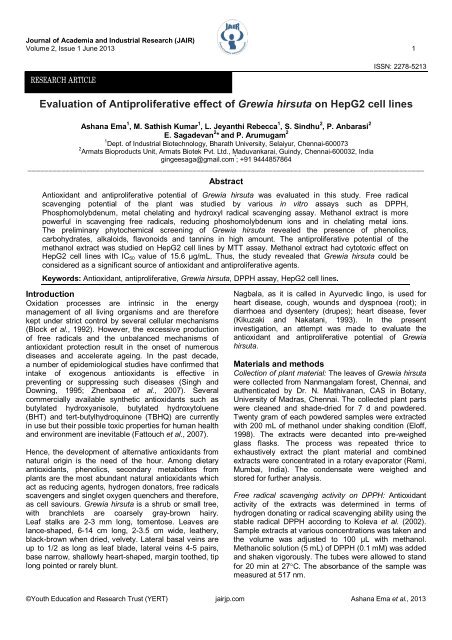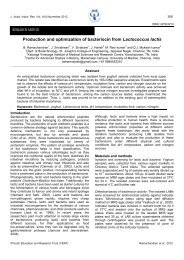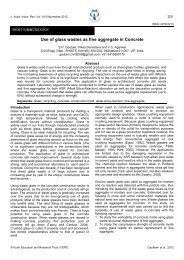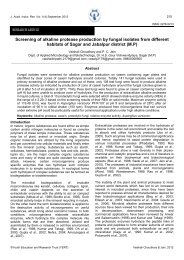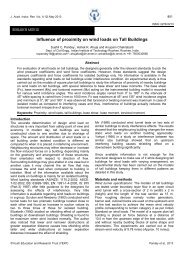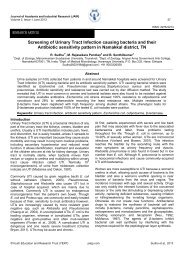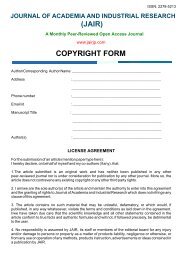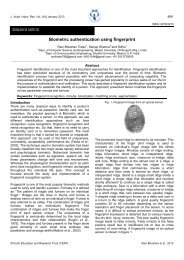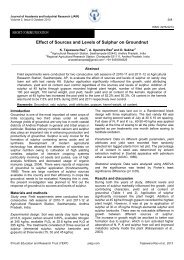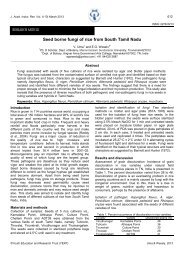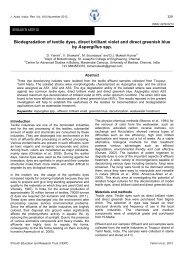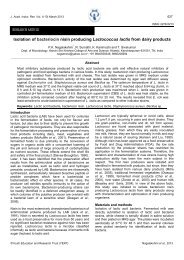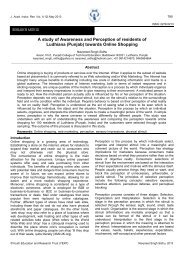Evaluation of Antiproliferative effect of Grewia hirsuta on HepG2 cell ...
Evaluation of Antiproliferative effect of Grewia hirsuta on HepG2 cell ...
Evaluation of Antiproliferative effect of Grewia hirsuta on HepG2 cell ...
You also want an ePaper? Increase the reach of your titles
YUMPU automatically turns print PDFs into web optimized ePapers that Google loves.
Journal <str<strong>on</strong>g>of</str<strong>on</strong>g> Academia and Industrial Research (JAIR)Volume 2, Issue 1 June 2013 1RESEARCH ARTICLEISSN: 2278-5213<str<strong>on</strong>g>Evaluati<strong>on</strong></str<strong>on</strong>g> <str<strong>on</strong>g>of</str<strong>on</strong>g> <str<strong>on</strong>g>Antiproliferative</str<strong>on</strong>g> <str<strong>on</strong>g>effect</str<strong>on</strong>g> <str<strong>on</strong>g>of</str<strong>on</strong>g> <str<strong>on</strong>g>Grewia</str<strong>on</strong>g> <str<strong>on</strong>g>hirsuta</str<strong>on</strong>g> <strong>on</strong> <strong>HepG2</strong> <strong>cell</strong> linesAshana Ema 1 , M. Sathish Kumar 1 , L. Jeyanthi Rebecca 1 , S. Sindhu 2 , P. Anbarasi 2E. Sagadevan 2 * and P. Arumugam 21 Dept. <str<strong>on</strong>g>of</str<strong>on</strong>g> Industrial Biotechnology, Bharath University, Selaiyur, Chennai-6000732 Armats Bioproducts Unit, Armats Biotek Pvt. Ltd., Maduvankarai, Guindy, Chennai-600032, Indiagingeesaga@gmail.com * ; +91 9444857864______________________________________________________________________________________________AbstractAntioxidant and antiproliferative potential <str<strong>on</strong>g>of</str<strong>on</strong>g> <str<strong>on</strong>g>Grewia</str<strong>on</strong>g> <str<strong>on</strong>g>hirsuta</str<strong>on</strong>g> was evaluated in this study. Free radicalscavenging potential <str<strong>on</strong>g>of</str<strong>on</strong>g> the plant was studied by various in vitro assays such as DPPH,Phosphomolybdenum, metal chelating and hydroxyl radical scavenging assay. Methanol extract is morepowerful in scavenging free radicals, reducing phoshomolybdenum i<strong>on</strong>s and in chelating metal i<strong>on</strong>s.The preliminary phytochemical screening <str<strong>on</strong>g>of</str<strong>on</strong>g> <str<strong>on</strong>g>Grewia</str<strong>on</strong>g> <str<strong>on</strong>g>hirsuta</str<strong>on</strong>g> revealed the presence <str<strong>on</strong>g>of</str<strong>on</strong>g> phenolics,carbohydrates, alkaloids, flav<strong>on</strong>oids and tannins in high amount. The antiproliferative potential <str<strong>on</strong>g>of</str<strong>on</strong>g> themethanol extract was studied <strong>on</strong> <strong>HepG2</strong> <strong>cell</strong> lines by MTT assay. Methanol extract had cytotoxic <str<strong>on</strong>g>effect</str<strong>on</strong>g> <strong>on</strong><strong>HepG2</strong> <strong>cell</strong> lines with IC 50 value <str<strong>on</strong>g>of</str<strong>on</strong>g> 15.6 µg/mL. Thus, the study revealed that <str<strong>on</strong>g>Grewia</str<strong>on</strong>g> <str<strong>on</strong>g>hirsuta</str<strong>on</strong>g> could bec<strong>on</strong>sidered as a significant source <str<strong>on</strong>g>of</str<strong>on</strong>g> antioxidant and antiproliferative agents.Keywords: Antioxidant, antiproliferative, <str<strong>on</strong>g>Grewia</str<strong>on</strong>g> <str<strong>on</strong>g>hirsuta</str<strong>on</strong>g>, DPPH assay, <strong>HepG2</strong> <strong>cell</strong> lines.Introducti<strong>on</strong>Oxidati<strong>on</strong> processes are intrinsic in the energymanagement <str<strong>on</strong>g>of</str<strong>on</strong>g> all living organisms and are thereforekept under strict c<strong>on</strong>trol by several <strong>cell</strong>ular mechanisms(Block et al., 1992). However, the excessive producti<strong>on</strong><str<strong>on</strong>g>of</str<strong>on</strong>g> free radicals and the unbalanced mechanisms <str<strong>on</strong>g>of</str<strong>on</strong>g>antioxidant protecti<strong>on</strong> result in the <strong>on</strong>set <str<strong>on</strong>g>of</str<strong>on</strong>g> numerousdiseases and accelerate ageing. In the past decade,a number <str<strong>on</strong>g>of</str<strong>on</strong>g> epidemiological studies have c<strong>on</strong>firmed thatintake <str<strong>on</strong>g>of</str<strong>on</strong>g> exogenous antioxidants is <str<strong>on</strong>g>effect</str<strong>on</strong>g>ive inpreventing or suppressing such diseases (Singh andDowning, 1995; Zhenbaoa et al., 2007). Severalcommercially available synthetic antioxidants such asbutylated hydroxyanisole, butylated hydroxytoluene(BHT) and tert-butylhydroquin<strong>on</strong>e (TBHQ) are currentlyin use but their possible toxic properties for human healthand envir<strong>on</strong>ment are inevitable (Fattouch et al., 2007).Hence, the development <str<strong>on</strong>g>of</str<strong>on</strong>g> alternative antioxidants fromnatural origin is the need <str<strong>on</strong>g>of</str<strong>on</strong>g> the hour. Am<strong>on</strong>g dietaryantioxidants, phenolics, sec<strong>on</strong>dary metabolites fromplants are the most abundant natural antioxidants whichact as reducing agents, hydrogen d<strong>on</strong>ators, free radicalsscavengers and singlet oxygen quenchers and therefore,as <strong>cell</strong> saviours. <str<strong>on</strong>g>Grewia</str<strong>on</strong>g> <str<strong>on</strong>g>hirsuta</str<strong>on</strong>g> is a shrub or small tree,with branchlets are coarsely gray-brown hairy.Leaf stalks are 2-3 mm l<strong>on</strong>g, tomentose. Leaves arelance-shaped, 6-14 cm l<strong>on</strong>g, 2-3.5 cm wide, leathery,black-brown when dried, velvety. Lateral basal veins areup to 1/2 as l<strong>on</strong>g as leaf blade, lateral veins 4-5 pairs,base narrow, shallowly heart-shaped, margin toothed, tipl<strong>on</strong>g pointed or rarely blunt.Nagbala, as it is called in Ayurvedic lingo, is used forheart disease, cough, wounds and dyspnoea (root); indiarrhoea and dysentery (drupes); heart disease, fever(Kikuzaki and Nakatani, 1993). In the presentinvestigati<strong>on</strong>, an attempt was made to evaluate theantioxidant and antiproliferative potential <str<strong>on</strong>g>of</str<strong>on</strong>g> <str<strong>on</strong>g>Grewia</str<strong>on</strong>g><str<strong>on</strong>g>hirsuta</str<strong>on</strong>g>.Materials and methodsCollecti<strong>on</strong> <str<strong>on</strong>g>of</str<strong>on</strong>g> plant material: The leaves <str<strong>on</strong>g>of</str<strong>on</strong>g> <str<strong>on</strong>g>Grewia</str<strong>on</strong>g> <str<strong>on</strong>g>hirsuta</str<strong>on</strong>g>were collected from Nanmangalam forest, Chennai, andauthenticated by Dr. N. Mathivanan, CAS in Botany,University <str<strong>on</strong>g>of</str<strong>on</strong>g> Madras, Chennai. The collected plant partswere cleaned and shade-dried for 7 d and powdered.Twenty gram <str<strong>on</strong>g>of</str<strong>on</strong>g> each powdered samples were extractedwith 200 mL <str<strong>on</strong>g>of</str<strong>on</strong>g> methanol under shaking c<strong>on</strong>diti<strong>on</strong> (El<str<strong>on</strong>g>of</str<strong>on</strong>g>f,1998). The extracts were decanted into pre-weighedglass flasks. The process was repeated thrice toexhaustively extract the plant material and combinedextracts were c<strong>on</strong>centrated in a rotary evaporator (Remi,Mumbai, India). The c<strong>on</strong>densate were weighed andstored for further analysis.Free radical scavenging activity <strong>on</strong> DPPH: Antioxidantactivity <str<strong>on</strong>g>of</str<strong>on</strong>g> the extracts was determined in terms <str<strong>on</strong>g>of</str<strong>on</strong>g>hydrogen d<strong>on</strong>ating or radical scavenging ability using thestable radical DPPH according to Koleva et al. (2002).Sample extracts at various c<strong>on</strong>centrati<strong>on</strong>s was taken andthe volume was adjusted to 100 μL with methanol.Methanolic soluti<strong>on</strong> (5 mL) <str<strong>on</strong>g>of</str<strong>on</strong>g> DPPH (0.1 mM) was addedand shaken vigorously. The tubes were allowed to standfor 20 min at 27C. The absorbance <str<strong>on</strong>g>of</str<strong>on</strong>g> the sample wasmeasured at 517 nm.©Youth Educati<strong>on</strong> and Research Trust (YERT) jairjp.com Ashana Ema et al., 2013
Journal <str<strong>on</strong>g>of</str<strong>on</strong>g> Academia and Industrial Research (JAIR)Volume 2, Issue 1 June 2013 2Radical scavenging activity was expressed as theinhibiti<strong>on</strong> percentage <str<strong>on</strong>g>of</str<strong>on</strong>g> free radical by the sample andwas calculated using the formula:% DPPH activity = (C<strong>on</strong>trol OD–Sample OD/C<strong>on</strong>trol OD) × 100.Phosphomolybdenum assay: Antioxidant activity <str<strong>on</strong>g>of</str<strong>on</strong>g>samples was evaluated by green phosphomolybdenumcomplex formati<strong>on</strong> according to Prieto et al. (1999).An aliquot <str<strong>on</strong>g>of</str<strong>on</strong>g> 100 μL <str<strong>on</strong>g>of</str<strong>on</strong>g> sample soluti<strong>on</strong> was combinedwith 1 mL <str<strong>on</strong>g>of</str<strong>on</strong>g> reagent soluti<strong>on</strong> (0.6 M sulphuric acid,28 mM sodium phosphate and 4 mM amm<strong>on</strong>iummolybdate) in a 4 mL vial. The vials were capped andincubated in a water bath at 95C for 90 min. Aftercooling, the absorbance <str<strong>on</strong>g>of</str<strong>on</strong>g> the mixture was measured at695 nm against a blank. Ascorbic acid (10 mg/mLDMSO) was used as standard. The results were reportedas % phosphomolybdenum reducti<strong>on</strong> potential.Hydroxyl radical scavenging activity: The scavengingactivity <str<strong>on</strong>g>of</str<strong>on</strong>g> the methanol extracts <strong>on</strong> hydroxyl radical wasmeasured according to Klein et al. (1992). Variousc<strong>on</strong>centrati<strong>on</strong>s (250, 500, 750 and 1000 μg/mL) <str<strong>on</strong>g>of</str<strong>on</strong>g>extracts were added with 1.0 mL <str<strong>on</strong>g>of</str<strong>on</strong>g> ir<strong>on</strong>‐EDTA soluti<strong>on</strong>,0.5 mL <str<strong>on</strong>g>of</str<strong>on</strong>g> EDTA soluti<strong>on</strong> and 1.0 mL <str<strong>on</strong>g>of</str<strong>on</strong>g> dimethylsulphoxide (DMSO). The reacti<strong>on</strong> was initiated by adding0.5 mL <str<strong>on</strong>g>of</str<strong>on</strong>g> ascorbic acid and incubated at 80-90C for15 min in a water bath. After incubati<strong>on</strong> the reacti<strong>on</strong> wasterminated by the additi<strong>on</strong> <str<strong>on</strong>g>of</str<strong>on</strong>g> 1.0 mL <str<strong>on</strong>g>of</str<strong>on</strong>g> ice‐cold TCA.Nash reagent (3 mL) was added and left at roomtemperature for 15 min. The reacti<strong>on</strong> mixture withoutsample was used as c<strong>on</strong>trol. The intensity <str<strong>on</strong>g>of</str<strong>on</strong>g> the colorformed was measured spectroscopically at 412 nmagainst reagent blank. The % hydroxyl radicalscavenging activity (HRSA) is calculated by the followingformula:% HRSA = [(Abs c<strong>on</strong>trol‐Abs sample)/Abs c<strong>on</strong>trol] × 100Where, Abs c<strong>on</strong>trol is the absorbance <str<strong>on</strong>g>of</str<strong>on</strong>g> the c<strong>on</strong>trol;Abs sample is the absorbance <str<strong>on</strong>g>of</str<strong>on</strong>g> the extract/standard.Metal chelating activity: The chelating <str<strong>on</strong>g>effect</str<strong>on</strong>g> <str<strong>on</strong>g>of</str<strong>on</strong>g> ferrousi<strong>on</strong>s by the extracts was estimated according to Diniset al. (1994). Hundred μL <str<strong>on</strong>g>of</str<strong>on</strong>g> the extract was added to0.05 mL <str<strong>on</strong>g>of</str<strong>on</strong>g> 2 mM FeCl 2 . The reacti<strong>on</strong> was initiated by theadditi<strong>on</strong> <str<strong>on</strong>g>of</str<strong>on</strong>g> 0.2 mL <str<strong>on</strong>g>of</str<strong>on</strong>g> ferrozine (5 mM) and the mixturewas shaken vigorously and left at room temperature for10 min. Absorbance <str<strong>on</strong>g>of</str<strong>on</strong>g> the soluti<strong>on</strong> was then measuredspectrophotometrically at 562 nm. The chelating activity<str<strong>on</strong>g>of</str<strong>on</strong>g> the extracts was evaluated using EDTA as standard.The results were expressed as % metal chelatingactivity. The ratio <str<strong>on</strong>g>of</str<strong>on</strong>g> inhibiti<strong>on</strong> <str<strong>on</strong>g>of</str<strong>on</strong>g> ferrozine Fe 2+ complexwas calculated as follows:% inhibiti<strong>on</strong> = (C<strong>on</strong>trol OD–Sample OD/C<strong>on</strong>trol OD) × 100.Qualitative and quantitative phytochemical screening:The extracts were subjected to preliminaryphytochemical screening to identify the presence <str<strong>on</strong>g>of</str<strong>on</strong>g>phytoc<strong>on</strong>stituents such as alkaloids, flav<strong>on</strong>oids,sap<strong>on</strong>ins, tannins, phenols, glycosides and steroidsaccording to Harborne (1973).Estimati<strong>on</strong> <str<strong>on</strong>g>of</str<strong>on</strong>g> total free phenolics: Total phenolicc<strong>on</strong>stituents <str<strong>on</strong>g>of</str<strong>on</strong>g> plant extracts were estimated byFolin-Ciocalteau’s method using Folin-Ciocalteu reagent.The estimati<strong>on</strong> was d<strong>on</strong>e spectrometrically at 760 nmand the results were expressed as gallic acid equivalents(GAE) (Sengul et al., 2009).Estimati<strong>on</strong> <str<strong>on</strong>g>of</str<strong>on</strong>g> total flav<strong>on</strong>oids: Aluminium chloride methodwas employed to quantify the total flav<strong>on</strong>oid c<strong>on</strong>tent inthe plant extracts. The results were expressed asquercetin equivalents (QE) (Chang et al., 2002).Estimati<strong>on</strong> <str<strong>on</strong>g>of</str<strong>on</strong>g> total alkaloids: Total alkaloid c<strong>on</strong>tent <str<strong>on</strong>g>of</str<strong>on</strong>g> theplant extracts was determined according to Sutharsinghet al. (2011). Five gram <str<strong>on</strong>g>of</str<strong>on</strong>g> the sample was filtered andc<strong>on</strong>centrated to <strong>on</strong>e quarter <str<strong>on</strong>g>of</str<strong>on</strong>g> the original volume <strong>on</strong> awater bath after treatment with 200 mL <str<strong>on</strong>g>of</str<strong>on</strong>g> 10% aceticacid in ethanol. C<strong>on</strong>centrated NH 4 OH was addeddrop wise to the extract until the precipitati<strong>on</strong> wascomplete. The whole soluti<strong>on</strong> was allowed to settle andthe precipitate was collected and washed with diluteNH 4 OH, filtered and weighed.Estimati<strong>on</strong> <str<strong>on</strong>g>of</str<strong>on</strong>g> total sap<strong>on</strong>ins: Powdered sample (20 g)was treated with 100 mL <str<strong>on</strong>g>of</str<strong>on</strong>g> 20% aqueous ethanol,heated over a hot water bath for 4 h at about 55°C withc<strong>on</strong>tinuous stirring. The mixture was filtered and theresidue re-extracted. The combined extracts werereduced to 40 mL over water bath at about 90°C and thec<strong>on</strong>centrate was transferred into a separating funnel and20 mL <str<strong>on</strong>g>of</str<strong>on</strong>g> diethyl ether was added and shaken vigorously.The aqueous layer was recovered while the ether layerwas discarded. The purificati<strong>on</strong> process was repeatedand 60 mL <str<strong>on</strong>g>of</str<strong>on</strong>g> n-butanol was added to the combinedextracts and washed twice with 10 mL <str<strong>on</strong>g>of</str<strong>on</strong>g> 5% aqueousNaCl. The remaining soluti<strong>on</strong> was heated in a waterbath, dried in an oven to a c<strong>on</strong>stant weight and thesap<strong>on</strong>in c<strong>on</strong>tent was calculated as percentage(Sutharsingh et al., 2011).Thin layer chromatography: The plant extract was loaded<strong>on</strong> pre-coated silica plates which were then developedusing methanol, chlor<str<strong>on</strong>g>of</str<strong>on</strong>g>orm in the ratio <str<strong>on</strong>g>of</str<strong>on</strong>g> 1:9. The spotswere identified both in the UV light and in the iodinechamber. Then R f value was calculated as the ratio <str<strong>on</strong>g>of</str<strong>on</strong>g>distance travelled by the solute to the distance travelledby the solvent (El<str<strong>on</strong>g>of</str<strong>on</strong>g>f, 1998).Bioautography: The extract which showed DPPHinhibiti<strong>on</strong> <str<strong>on</strong>g>of</str<strong>on</strong>g> more than 90% was examined by thin layerchromatography (TLC) bioautography.©Youth Educati<strong>on</strong> and Research Trust (YERT) jairjp.com Ashana Ema et al., 2013
Journal <str<strong>on</strong>g>of</str<strong>on</strong>g> Academia and Industrial Research (JAIR)Volume 2, Issue 1 June 2013 3The plant extract was applied to pre-coated thin layerchromatography sheet and run with the developingsolvent mixture then allow it for dry. After drying theplates, it was dipped in 0.2% DPPH reagent in methanolor ethanol and was left for 30 min at room temperature.The plates were observed under white light. Antioxidantactivity was c<strong>on</strong>firmed when the DPPH purple colorchanged to yellow (Saleh et al., 2010).Results and discussi<strong>on</strong>Radical scavenging activity <str<strong>on</strong>g>of</str<strong>on</strong>g> leaf extracts: The DPPHradical is widely used to evaluate the free-radicalscavenging capacity <str<strong>on</strong>g>of</str<strong>on</strong>g> antioxidants (Zhenbao et al.,2007). From the dose dependent resp<strong>on</strong>se curve,DPPH radical scavenging activity <str<strong>on</strong>g>of</str<strong>on</strong>g> different plantextracts <str<strong>on</strong>g>of</str<strong>on</strong>g> <str<strong>on</strong>g>Grewia</str<strong>on</strong>g> <str<strong>on</strong>g>hirsuta</str<strong>on</strong>g> was observed. At ac<strong>on</strong>centrati<strong>on</strong> <str<strong>on</strong>g>of</str<strong>on</strong>g> 200 µg, the scavenging activity <str<strong>on</strong>g>of</str<strong>on</strong>g>methanol extract reached 95%. The methanol extract <str<strong>on</strong>g>of</str<strong>on</strong>g><str<strong>on</strong>g>Grewia</str<strong>on</strong>g> <str<strong>on</strong>g>hirsuta</str<strong>on</strong>g> showed good antioxidant and free radicalscavenging activity (Fig. 1). In a similar study, the DPPHradical scavenging activity <str<strong>on</strong>g>of</str<strong>on</strong>g> solvent fracti<strong>on</strong>s <str<strong>on</strong>g>of</str<strong>on</strong>g> Cassiatora was studied in which, ethyl acetate extract showedthe highest scavenging activity with an EC 50 value <str<strong>on</strong>g>of</str<strong>on</strong>g>70.1 µg/mL (Zhenbao et al., 2007).Hydroxyl radical scavenging activity: Hydroxyl radical is aform <str<strong>on</strong>g>of</str<strong>on</strong>g> ROS and is associated with arthritis, cytotoxic,mutagenic and genotoxic involved in diseasepathogenesis (Naithani et al., 2011). The hydroxyl radicalis <strong>on</strong>e <str<strong>on</strong>g>of</str<strong>on</strong>g> representative reactive oxygen speciesgenerated in the body and these radicals are producedthrough various biological reacti<strong>on</strong>s; <strong>on</strong>e <str<strong>on</strong>g>of</str<strong>on</strong>g> the comm<strong>on</strong>reacti<strong>on</strong>s is the Ir<strong>on</strong> (II) based Fent<strong>on</strong> reacti<strong>on</strong>.According to Koo et al. (2004), Genipin, active principal<str<strong>on</strong>g>of</str<strong>on</strong>g> Gardenia possesses anti-inflammatory and is aspecific hydroxyl radical. The radical scavenging capacitymay be attributed to phenolic compounds in methanolextract with the ability to accept electr<strong>on</strong>s, which cancombine with free radical to decrease hydroxyl radical(Fig. 2).Metal chelating activity: Transiti<strong>on</strong> metal has played apivotal role in the generati<strong>on</strong> <str<strong>on</strong>g>of</str<strong>on</strong>g> oxygen free radicals inliving organisms. Chelating agents may inactivate metali<strong>on</strong>s and potentially inhibit the metal-dependentprocesses (Finefrock et al., 2003). Presence <str<strong>on</strong>g>of</str<strong>on</strong>g> transiti<strong>on</strong>metal i<strong>on</strong>s in a biological system could catalyse theHaber–Weiss and Fent<strong>on</strong>‐type reacti<strong>on</strong>s, resulting ingenerati<strong>on</strong> <str<strong>on</strong>g>of</str<strong>on</strong>g> hydroxyl radicals (OH). However, thesetransiti<strong>on</strong> metal i<strong>on</strong>s could form chelates with theantioxidants, which result in the suppressi<strong>on</strong> <str<strong>on</strong>g>of</str<strong>on</strong>g> OHgenerati<strong>on</strong> and inhibiti<strong>on</strong> <str<strong>on</strong>g>of</str<strong>on</strong>g> peroxidati<strong>on</strong> <str<strong>on</strong>g>of</str<strong>on</strong>g> biologicalmolecules. Metal i<strong>on</strong> chelating activity <str<strong>on</strong>g>of</str<strong>on</strong>g> an antioxidantmolecule prevents generati<strong>on</strong> and the c<strong>on</strong>sequentdamage. Metal i<strong>on</strong> chelating capacity plays a significantrole in antioxidant mechanisms since it reduces thec<strong>on</strong>centrati<strong>on</strong> <str<strong>on</strong>g>of</str<strong>on</strong>g> catalyzing transiti<strong>on</strong> metal in LPO(Sudha et al., 2011).Fig. 1. DPPH radical scavenging activity <str<strong>on</strong>g>of</str<strong>on</strong>g> G. <str<strong>on</strong>g>hirsuta</str<strong>on</strong>g>methanolic extract.Fig. 2. Hydroxyl radical scavenging activity <str<strong>on</strong>g>of</str<strong>on</strong>g> G. <str<strong>on</strong>g>hirsuta</str<strong>on</strong>g>methanolic extract.0.3OD at 412 nm% Radical scavenging activity10090807060504030201000.250.20.150.10.05020 40 60 80 100 120 140 160 180 200C<strong>on</strong>c. (µg/mL)Fig. 3. Metal chelating activity <str<strong>on</strong>g>of</str<strong>on</strong>g> G. <str<strong>on</strong>g>hirsuta</str<strong>on</strong>g> methanolic extract.OD at 562 nm0.70.60.50.40.30.20.10250 500 750 1000C<strong>on</strong>c. (µg/mL)C<strong>on</strong>trol Test StandardFig. 4. Phosphomolybdenum reducing activity <str<strong>on</strong>g>of</str<strong>on</strong>g> G. <str<strong>on</strong>g>hirsuta</str<strong>on</strong>g>methanolic extract.OD at 695 nm2.521.510.50C<strong>on</strong>trol Test Standard©Youth Educati<strong>on</strong> and Research Trust (YERT) jairjp.com Ashana Ema et al., 2013


